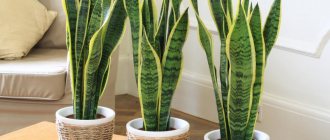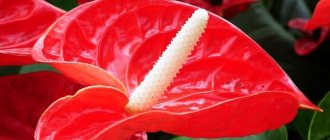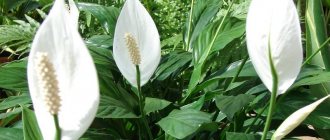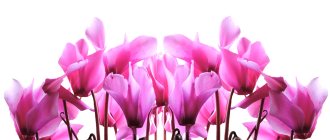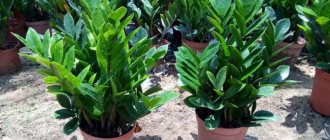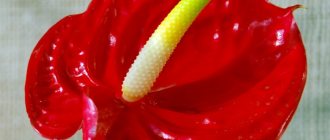Popular beliefs and observations
Fuchsia is not only an attractive houseplant, it is a real home talisman . It is believed that the flower is able to protect its owners from damage, the evil eye and other harm, and fill it with energy to overcome any difficulties.
- The flower is given to newlyweds for a strong relationship and strong family life.
- Fuchsia presented to new residents will help create a harmonious, comfortable and cozy atmosphere in the new place.
- For people with diseases of the thyroid gland, gastrointestinal tract, and mammary glands, the plant acts as a healer, causing the disease to recede as quickly as possible.
- The flower endows its owner with charm, femininity, and tenderness. If a woman carefully cares for the plant, she will never be left without the attention and care of the opposite sex.
Why does it bloom?
During the flowering period, the magical effects of fuchsia are especially effective.
- If the flower is covered with buds , this means successful implementation of plans and increased prosperity. A good time to start your own business and move up the career ladder.
- If fuchsia blooms in the house of a lonely person , in the near future he will meet his soulmate and have a relationship filled with mutual love and harmony. At the same time, the development of relations will be rapid and will soon lead to marriage.
- Blooming fuchsia helps resolve the most difficult issues, gives the owner the ability to find innovative solutions, and inspires discoveries and achievements in any field: creativity, science and medicine.
Why do you dream?
Dreaming of fuchsia is a sign that the dreamer is protected from envy, unkind thoughts addressed to him, the evil eye, damage and other negative magical influences.
If you dreamed of several flowers - to a successful course of affairs, the embodiment of conceived ideas and dreams into reality.
What is it: general description
Fuchsia is an ornamental plant from the fireweed family . These are small trees or shrubs with flexible shoots of a reddish color, medium-sized lacent or ovate leaves located opposite, and numerous flowers of various shapes and colors.
This ornamental crop has a bushy or creeping appearance. A distinctive feature of fuchsia is the flower. It consists of two parts - a corolla-shaped calyx and a bell-shaped or tubular corolla (skirt) of a different color. All parts of the flower are brightly colored.
Fuchsia varieties that have 4-5 petals and a rather small flower are called non-double . Large fuchsias, the corolla of which consists of many petals, are considered terry.
Attention : This culture belongs to the group of unpretentious plants. Fuchsia is easy to care for and grow and perfectly decorates the interior.
Origin: Brief History
Fuchsia is named after the famous German scientist, botanist and physician Leonard Fuchs .
This plant was discovered by Catholic priest Charles Plumier at the end of the 17th century. He traveled across the South American continent in search of medicinal plants and found this plant there. In 1703, in the book Nova Planetarium Americanum Genera, an article about the discovery of a new species was first published. According to the generally accepted version, this date became the “birthday” of fuchsia.
Is it possible to keep the plant in the house?
Fuchsia in the house is a kind of talisman of well-being and success . It charges household members with positive energy, joy, love of life, drives out bad moods and irritation, thereby reducing the number of quarrels and conflicts.
The benefits of an indoor flower
The plant helps people find a common language, fills the atmosphere in the house with mutual understanding, support, and mutual respect.
Fuchsia is especially indispensable where a large family of several generations lives under one roof. The flower eliminates resentment and alienation, allowing everyone to feel needed and loved .
If the plant is in the house for a long time, its owners develop intuition, and in some cases, the gift of clairvoyance.
The owners of the flower recover strength more easily and quickly after heavy physical or psychological stress, and release accumulated negative energy. To do this, it is enough to be near the fuchsia even for a short time. In addition, the plant gives household members endurance and performance.
How can it be dangerous?
Sometimes there is an opinion that fuchsia is a widow's flower. It is also called widow's tears. Some particularly superstitious people believe that the plant drives men out of the house . However, there is no explanation on what this negative idea of the plant is based. Each gardener will have to decide for himself whether to have fuchsia at home or not. But most flower owners do not pay attention to this superstition, considering it false.
What is a plant
The attractive appearance of Fuchsia will not allow either household members or guests to show indifference. The plant has numerous stems that can be flexibly positioned in any direction.
Abundantly arranged leaves cover the branches and have an unusually colored plate of pronounced green or reddish color. The leaf shape is oval-lanceolate, with a length of no more than 0.5 cm and a characteristic pointed end.
The flowers of the plant resemble a bell with elongated stamens.
Depending on the acquired species, the appearance may be simple, or it may differ in double flowers.
After a long (from April to mid-autumn) and abundant flowering, the buds leave behind edible sweet berries that can be used to make pies, liqueur, jam or decorate ice cream. The flowers themselves are also used to decorate salads.
People often call the flower “Ballerina”, due to its great resemblance to the figure of a ballerina.
Fuchsia. Home care
The gardener does not need to put a lot of effort into caring for Fuchsia.
The soil should not be excessively waterlogged or, conversely, dry. Maintaining constant humidity promises the plant a healthy appearance and long flowering. When flooding the soil, it must be drained and allowed to dry a little.
Brown-yellow spots on the leaves will help you understand that there is a lot of water in the earth. In the case of wilted leaves, but proper watering, the pet needs to take a shower or spray it, the flower really likes it.
The best time to moisten the soil, especially in summer, is considered to be early morning or evening, when there is no scorching sun.
The plant is characterized as resistant to diseases and pests.
If whiteflies appear, you should immediately wash the stems and lower parts of the leaves with warm water and laundry soap, avoiding contact with the ground and roots. A polyethylene film placed on top of the soil can serve as an excellent protection against penetration of the mixture.
Spider mites can appear in a flower when the plant is in a room with warm and dry air. In this case, the plant can only be saved by treatment with biological products.
Positive signs
Fuchsia belongs to a number of flowers that are purchased by housewives not only to decorate the house, but also to create a positive atmosphere.
This is due to the fact that the plant has been considered magical since ancient times and carries a number of signs and superstitions that endow all households with positivity and determination. But this is not the entire list of benefits of the flower.
For businessmen or people involved in activities that require developed intuition, a flower is simply irreplaceable.
Creative people must place Fuchsia at home for a surge of energy and vitality.
Harmonization of disturbed energy also applies to the ability of the plant.
When there are children in the family, Fuchsia located in the room, where household members of different ages often visit, will help to find common interests and eliminate misunderstandings between different generations.
In difficult situations, the plant will help you find a quick solution.
Think creatively and take non-standard actions that will help radiate creative energy.
For women caring for a flower, charm and charm are presented as gratitude.
A pot with a flower located in the house reduces the risk of diseases not only of the gastrointestinal tract, but also of the mammary and thyroid glands.
When purchasing a new home, the first plant that will strengthen auras and block the penetration of negative energy from the outside should be the Fuchsia flower.
A person who has this green pet always feels a surge of strength and stands out for his cheerfulness and love of life.
Negative signs
Most women who have Fuchsia on their windowsills do not attach much importance to its negative feature, associated with another belief that characterizes the plant as a widow's flower or widow's tears.
But experienced flower growers reassure the future owners of the flower that such a statement is unjustified and groundless.
Any appearance of yellow or black dots on the leaves does not carry any frightening signs. This only symbolizes improper care, watering or the development of any pests.
Loving Fuchsia and treating her like a member of the family will mark the beginning of strong friendships with all household members and the risk of a negative attitude will simply go away.
The plant cannot harm those who are gentle, friendly and attuned to the flower with an open soul.
Source
Feng Shui meaning of a flower
Feng Shui experts, depending on the shape of fuchsia leaves, attribute it either to the male Yang energy (if the leaves are pointed) or to the female Yin energy (if the leaves are round).
In accordance with this, the correct selection of plants for the home will allow you to adjust the energy inside the home, directing the effect of the flower in the right direction.
But no matter what shape the leaves of fuchsia have, the flower will always help its owners avoid troubles and problems , fill them with vitality, energy and inspiration.
Fuchsia. Ballerina flower
Flower growers' homes contain a large number of beautiful and inspiring plants.
Every housewife thinks about replenishing her greenhouse with Fuchsia, a flower belonging to the Fireweed family.
The birthplace of the perennial plant is considered to be Central and South America, as well as New Zealand.
At home they are used to decorate the room.
Where is the best place to put it?
The best choice for placing a fuchsia pot is the north-west or north-east side of the apartment.
In order for harmony, trust, mutual understanding and warm relationships to reign in the house, the plant is placed where all family members most often gather , for example, in the living room or kitchen.
To attract good luck in love, fuchsia is placed in the bedroom, but at some distance from the bed.
Fuchsia attracts attention with its bright appearance. However, it is loved not only for its flowering. The plant can have a huge positive impact on the atmosphere in the house as a whole and on each family member individually.
How to grow at home and in the garden?
They grow it indoors in pots on window sills, baskets, as hanging plants and in garden plots. The flower does not tolerate frost. In the spring it is planted in a flower garden, and in the fall it is taken to a cool room. Large pots are used for replanting. The stems are trimmed.
At first glance, it seems that fuchsia is unpretentious to grow. But there are a number of secrets. Basic care tips :
- It is not recommended to move the pots to another place so as not to lose leaves and buds;
- to give its crown a beautiful shape, it is necessary to trim and pinch the top no later than April;
- in winter she does not need bright light, otherwise she may shed leaves;
- It is necessary to remove the buds that appear in winter;
- low air humidity, high room temperature, poor watering lead to leaf fall;
- It is better to plant it in light pots so that the earth does not overheat (the plant may die);
- the optimal temperature for wintering is about 10°;
- It is recommended to grow it on windows located on the eastern and western parts of the house; on southern windows it must be protected from direct sunlight;
- It is better not to use windows on the north side; on them the plant grows with small leaves and flowers and blooms poorly;
- water with settled water, do not allow it to stagnate in the pan;
- generous flowering in the new season is facilitated by reduced watering in October and minor watering from November;
- spraying is necessary;
- from April to September it needs regular feeding with fertilizers intended for flowering;
- drafts or poor watering lead to the shedding of leaves;
- new buds are better formed if faded flower stalks are removed;
Brief answers to frequently asked questions
What are the differences between indoor plants and other types?
In indoor culture, preference is given to hybrid fuchsias . In English they are also called “Hybrid Fuchsia - F. x. Hybrid." These types of plants have collected all the best qualities of the original varieties. Hybrid varieties are unpretentious, resilient and grow very quickly at home.
The most popular and beautiful types of indoor fuchsias are:
- Fuchsia is elegant.
- Fuchsia brilliant.
- Fuchsia Magellanica.
- Fuchsia hybrid.
Is it possible to eat the fruit?
Fuchsia fruits are quite edible . In cooking, they are used to prepare various delicacies: jam, confitures, sweet sauces, liqueurs and fillings for pies. When ripe, the berries are black-purple in color, and cooks often use them to decorate their dishes.
Important : If you are hypersensitive, fuchsia can be harmful to your health. If the flower was treated with pesticides, then eating the fruit is dangerous to health.
Garden species and those that can be kept at home, their photos
To decorate gardens and parks, varieties of large fuchsias that are prone to strong growth are used . They have straight shoots and reach half a meter. Such plants require careful care and long-term shaping. Flowers can be of a wide variety of colors.
Garden fuchsias are represented by the following varieties.
Australian
Australian ones are tall, with rich, bright, large flowers (Matilda, Walsing).
Exotic terry
Exotic double fuchsias - flowers of medium and small size . They have a large selection of shades (Sarah Jane and Florentina).
Sapphires and Diamonds
Sapphires and Diamonds are high-type fuchsias with large flowers, combining white with a variety of brightly saturated blue shades (Capri, Ultramarine and Dark Secret).
Winter-hardy
Winter-hardy fuchsias - survive well under snow, even without shelter (Garden News, Bacon, Konstanz).
Three-leaved
Three-leaved fuchsias have leaves with a red tint, reach half a meter , and the flowers are small, dark coral, collected in racemes. They are also considered a container type (Express and Orient).
Hybrid varieties
Hybrid varieties are very common among indoor fuchsias. There are more than 2000 types of hybrids. They can be divided into bush and hanging.
Ampelous
Ampelous fuchsias are grown in hanging baskets and flowerpots, as they have flexible creeping or drooping shoots . Cascade, Alice Ashton, Imperial Crown, Hollies Beauty are well-known varieties of this species.
Bush
Bush fuchsias are recommended to be fixed on special supports. They are grown in pots or containers. Anabel, Henriette Ernst, Alisson Bell, Armbrough Campbell - varieties of bush fuchsias.
Indoor varieties
Indoor varieties of fuchsias differ in the type of flowers , they are divided into:
- simple - Brutus, Winston Churchill;
- semi-double - Satellite, Tennessee Walts;
- terry - Midge, Fashion, Swingtime;
- racemes - Yellow, Swanley, Leverkusen.
Does it bloom in winter?
Fuchsia can bloom in September and even until the end of autumn in warm weather. In winter, this crop enters a dormant period. To ensure normal wintering, it is necessary to place the fuchsia in a cool place and limit watering. Storage in the basement is suitable for this.
Is it perennial?
Fuchsia is a perennial shrub . Tolerates wintering well at home. The decorative properties of some varieties do not appear in the first year. There are varieties that reveal their potential in the second year of life. Garden fuchsias that are afraid of frost are brought indoors for the winter, observing the appropriate temperature conditions (find out how to preserve fuchsia in winter here). Pruning is carried out in the second half of winter, after which new shoots should appear. In spring, the flower must be propagated by cuttings.
Botanical facts
Fuchsia is an exotic bright pink flower that stands out against the dark green foliage. Their buds resemble winged bells with thin threads of stamens. Few people know, but nature colored the buds of some types of fuchsia purple, white and scarlet. The plant has a fairly compact size and rarely exceeds a meter in height. This is why flowers are so loved by gardeners and lovers of exotic potted plants.
